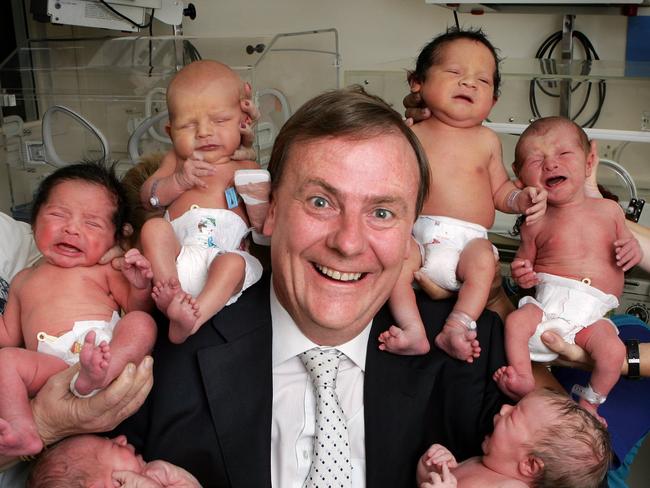Surprising results as Aussies vote on Baby Bonus
Australia is in a baby drought, prompting calls for the return of Peter Costello’s controversial bonus payment. See what readers think.
National
Don't miss out on the headlines from National. Followed categories will be added to My News.
Australians have rejected calls to reintroduce the controversial “Baby Bonus”.
A poll of News Corp readers revealed at least 72 per cent were opposed to the proposal, while only 28 per cent voted in favour of the financial incentive.
Readers commented they would rather see the money spent on combating the cost of living crisis, with others arguing the one-off payment would act as a “sugar hit” without easing long term financial pressures.
The baby bonus discussion comes as the latest Census data reveals concerning trends with the national birthrate.
Australia is in a baby drought, with a record-low birth rate threatening our future workforce and tax revenue – and leaving little support for the ageing population.
It’s prompting calls for a return of the baby bonus and significantly relaxed immigration policies.
Social analyst Mark McCrindle said the Baby Bonus payment – introduced in 2004 and worth between $3000 and $5437 – had been successful in helping to raise the Australian birthrate.
Mr McCrindle said he supported the reintroduction of a similar policy, which was offered to everyone who had a child, regardless of income or employment status.

He said it was a large enough payment to help with family expenses but not so large that the government covered the cost of raising the child.
“The policies have moved more to child care assistance … and that has its benefits, but it’s more around getting parents back into labour force,” Mr McCrindle, founder of research company McCrindle, said.
“I think the cash is the most equal (policy) – people can make their choices based on their particular circumstance and world view.
“Even if it went up to $10,000, it’s only token anyway compared to the costs of raising those kids.”

But the architect of the baby bonus – former treasurer Peter Costello – said the only way a similar payment would work today is if it came with strong messaging.
“I don’t think it was the payment itself that changed attitudes, it was the fact we talked about the problem and made people feel good about having more children,” Mr Costello, chair of sovereign wealth fund the Future Fund, said.
“(Twenty years ago) I said the best thing that could happen was if we could reverse the decline in fertility rate and I jokingly said ‘everyone should have one for mum, one for dad, one for country’ and for a while we arrested the birthrate and it actually ticked up.
“But then, in my view, we lost focus on the issue, and with various financial problems, it started to decline again.
“It takes a long time to turn these things around.”
The Association of Superannuation Funds of Australia is meanwhile calling for a different type of baby bonus – a $5000 superannuation payment made directly into the super account.
The idea has been presented to the government as they prepare the budget.
According to the Australian Bureau of Statistics, Australia had a total fertility rate of 1.58 births per woman in 2020 (294,369 babies).
This was down from 1.9 births per woman 30 years earlier, and down from 3.5 in 1961 at the height of the “baby boom”.
In 1991, Census figures showed 7.5 per cent of the Australian population was aged 0 to 4.
Last year, this figure was down to just 5.8 per cent of the population, meaning about 440,000 fewer young children than if we had maintained that 7.5 per cent rate.
That’s a 440,000-person hole in the future workforce – about the equivalent of the entire population of Malta.
But Australia cannot wait 20 or 30 years for population increases to flow through to the workforce.
Demographer Simon Kuestenmacher said Australia was already running out of working-age people.
“If you look at the future population profile of Australia in 2030, you see there will be a massive lack of people aged 25 to 33,” Mr Kuestenmacher said.
“The skill shortage is here to stay.”
He said the most cost-effective solution was to bring in skilled workers from overseas, but this was becoming more difficult as Australia was not the only country that needed more workers.
Mr Kuestenmacher suggested Australia follow the Canadian model and start “handing out citizenships to international students like candy”.
“You want future taxpayers in your country and international students are the best because they are educated to the level you require and they already have spent a couple of years in the country so are somewhat acclimatised,” he said.
“But what do we do? We make it very hard for them to acquire citizenship and to find jobs and make it a bureaucratic and expensive process.
“It’s not just mean but plain stupid.”
National, state and territory chambers of commerce are also calling on the federal government to tap into the supply of international graduates to help address Australia’s workforce shortages.
They want to allow current temporary graduate visa holders to stay and work longer; extend additional work rights to all graduates, not limited to select degrees; and extend temporary graduate work visas by an extra two years.
Australian Chamber of Commerce and Industry chief executive Andrew McKellar said it would be a “win-win”.
“By encouraging international graduates to extend their stay, businesses will have more access to critical skills in an extremely tight labour market,” he said.
More Coverage
Originally published as Surprising results as Aussies vote on Baby Bonus




